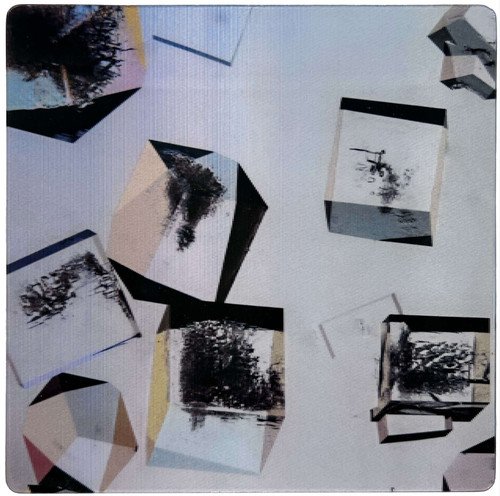Christine Lorenz

Artist Christine Lorenz photographs salt crystals and single use plastics as a way of connecting with the nonhuman world over time. This ongoing project began as something like a science experiment, and quickly turned into something more like gardening; the salt’s many ways of forming and dissolving seem to express an agency of its own. Through the tools of macro photography, salt formations come to suggest galaxies and impossible landscapes. Salt is a peculiar material; it’s familiar to all of us and has endless poetic associations, and the ways it changes form are endlessly fascinating. In our daily lives, plastics are just as abundant, but nowhere near as benign. What would it mean to have a poetics of plastic? How do we visualize the presence of this substance in the world? The connections that humans have to the environment through these everyday materials are complex, our entanglement so vast that it may be useful to grapple with just a little at a time. Lorenz makes images that aim to activate the imagination and cultivate attention to these aspects of our material world.
The crystals you see in Lorenz's photographs are normal table salt, which has crystalized in a shallow, transparent acrylic dish. This dish is then elevated above a light source, which has been coupled with a polarizing filter. This forces the light to come through in synchronized waves. The light then passes through layers of transparent plastics, which act as retarders. These not technical tools; they’re ordinary single-use plastics, mostly from product packaging. Lorenz chose these plastics for their ability to diffuse the light waves very slightly—just enough to create color effects that further refract when the light waves hit the salt crystals. The camera is pointing straight down at the crystals (and the layers of light, polarizing filter, and plastic retarders beneath them). There’s an additional polarizing filter on the camera that enhances the color effects, and rotating this filter shifts the range of colors that are visible.
Lenticular prints use very small-scale prisms to visually merge multiple images. This type of printing became popular in the second half of the 20th century as a format for things like political badges, travel souvenirs, holy cards, and the kind of small toys you might find in a cereal box. Today’s forms of lenticular printing can merge dozens of video frames, create realistic 3D imagery, or even make the effect tiny and flat enough to fit on a postage stamp. The version Lorenz uses for her series Halophilic 2.2 is the old-fashioned Crackerjack-prize type, which uses two matched photographs with different color effects. The two images are printed in precisely aligned, alternating rows, which correspond with the linear lenses. Each little rib on the surface of the print works like a lens to refract what’s behind it, which will shift depending on the angle from which it is seen. As your point of view on the image moves, the image that each little lens directs at your eye will shift from one image to the other. If you’re viewing the lenticular images in person with binocular vision, each eye’s perspective will be slightly different. This creates the shimmering effect of these prints.
Lorenz holds a dual BA in English and Photography from The Ohio State University and an MFA from the University of California, Santa Barbara. She has lived in Pittsburgh for over 20 years, and over most of that time has taught courses in visual culture and the history of photography at Duquesne University and Point Park University. Her photographs have been seen at photo-eye gallery in Santa Fe, in Pittsburgh spaces, and in collections across the United States and Europe. Her artwork has been featured by Lenscratch, CENTER Santa Fe, Vice, Photolucida, Fraction Magazine, Humble Arts Foundation, Magenta Foundation, and Rogue Agent Journal.
![]() View Christine Lorenz's artwork in the 2022 exhibition, The World at Our Feet.
View Christine Lorenz's artwork in the 2022 exhibition, The World at Our Feet.









